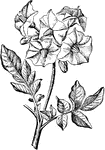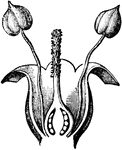
Plant House
A lean-to plant house which is associated with the growth of ornamental plant and flowers.

Root-Grafting of Dahlia
Grafting is a method of asexual plant propagation widely used in agriculture and horticulture where…
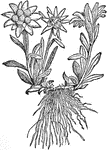
Edelweiss
Edelweiss (Leontopodium alpinum) is a European mountain flower of the Asteraceae or daisy family.

Fumitory (Side-view)
An illustration of the side-view of the fumitory flower Fumaria is a genus of about fifty annual herbaceous…

Fumitory Flower (Longitudinal Section)
An illustration of a longitudinal section of the fumitory flower. Fumaria is a genus of about fifty…
Fumitory Flower Anther
An illustration of a fumitory flower anther. Fumaria is a genus of about fifty annual herbaceous flowering…

Cardamine
An illustration of: A, Inflorescence and cauline leaves; B, Radical leaves and root. Cardamine (Car-dá-mi-ne,…

Berberis Flower
An illustration of the berberis flower. Berberis (Bér-be-ris, barberry, pepperidge bush) a genus…

elecampane
The Elecampane (Inula helenium) is a flowering plant in the Asteraceae family of daisies.
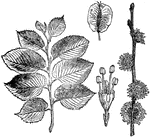
English Elm
Now known as Ulmus procera, the image shows a "Flowering Branch and Foliage of English Elm (Ulmus campestris),…

Myrtle
The Myrtle (Myrtus) is a genus of one or two species of flowering plants in the family Myrtaceae, native…

Carrot Flower
An illustration of the inflorescence of the carrot plant. An inflorescence is a group or cluster of…

Fructification of Carrot Flower
An illustration of fructification of the carrot flower. Fructification is a term used in the plant morphology…
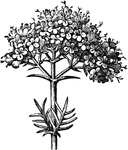
Valerian Inflorescence
Valerian is a hardy perennial flowering plant, with heads of sweetly scented pink or white flowers.…

Valerian Flower
Valerian is a hardy perennial flowering plant, with heads of sweetly scented pink or white flowers.…

Valerian Flower (Longitudinal Section)
An illustration of a longitudinal sectional view of the valerian flower. Valerian is a hardy perennial…

Valerian Seed with Pappus
An illustration of the valerian seed with attached pappus. In a composite flower, Pappus is the part…
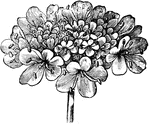
Inflorescence of Field Scabious
An illustration of the inflorescence of the field scabious. Knautia arvensis, commonly known as Field…
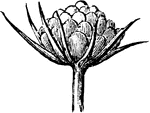
Young Inflorescence of Field Scabious
An illustration of the young inflorescence of the field scabious. Knautia arvensis, commonly known as…

Ray-floret of Field Scabious
An illustration of a ray-floret of the field scabious. Knautia arvensis, commonly known as Field Scabious,…

Ray-floret of Field Scabious
An illustration of a ray-floret of the field scabious. Knautia arvensis, commonly known as Field Scabious,…

Seed of Field Scabious
An illustration of the seed of the field scabious. Knautia arvensis, commonly known as Field Scabious,…

Inflorescence of a Cornflower
An illustration of the inflorescence of the cornflower. Centaurea cyanus ('Cornflower, Bachelor's button,…

Ray-floret of a Cornflower
An illustration of a ray-floret of the cornflower. Centaurea cyanus ('Cornflower, Bachelor's button,…
Disk-floret of a Cornflower
An illustration of a disk-floret of the cornflower. Centaurea cyanus ('Cornflower, Bachelor's button,…
Disk-floret of a Cornflower (Longitudinal
An illustration of a longitudinal section view of a disk-floret of the cornflower. Centaurea cyanus…
Disk-floret of the Senecio
An illustration of a disk-floret of the senecio flower. Senecio is a genus of the daisy family (Asteraceae)…

Disk-floret of the Senecio (Longitudinal Section)
An longitudinal section view of a disk-floret of the senecio flower. Senecio is a genus of the daisy…

Female ray-floret of the Senecio
An illustration of a ray-floret of the senecio flower. Senecio is a genus of the daisy family (Asteraceae)…
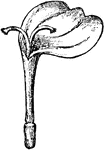
Gynaeceum of the Senecio
An illustration of the gynaeceum of the senecio flower. Senecio is a genus of the daisy family (Asteraceae)…

Comfrey Flower
Comfrey (also comphrey) is an important herb in organic gardening, having many medicinal and fertilizer…

Viper's Bugloss Flower
Echium vulgare (Viper's Bugloss) is a species of Echium native to most of Europe, and western and central…
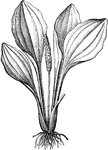
Plantain Flower
An illustration of a plantain plant. The plantain is a crop in the genus Musa and is generally used…

Plantain Flower and Bract
An illustration of a plantain plant flower and bract. In botany, a bract is a modified or specialized…
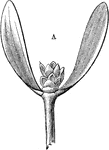
Mistletoe Flower
An illustration of the flower of the mistletoe plant. Mistletoe is the common name for a group of hemi-parasitic…
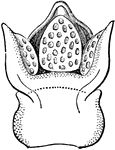
Mistletoe Staminate
An illustration of one staminate flower in section, magnified twelve times. Mistletoe is the common…
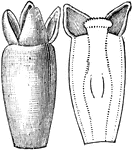
One Pistillate Flower of Mistletoe
An illustration of one pistillate flower of mistletoe. Mistletoe is the common name for a group of hemi-parasitic…
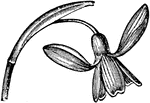
Snowdrop
Snowdrop is the common name for members of the genus Galanthus, a small genus of about 20 species in…

Sedge
An illustration of the female flower of the sedge plant. Carex is a genus of plants in the family Cyperaceae,…
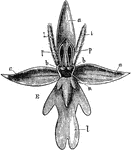
Fly Orchid
Fly orchid (Ophrys insectifera) is a plant of the family Orchidaceae, a native of the British Isles…
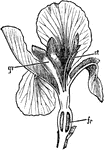
Iris
Iris is a genus of between 200-300 species of flowering plants with showy flowers. It takes its name…

Turk's Cap Lily
Lilium martagon (Martagon or Turk's cap lily) is a species of lily. It has a widespread native region…
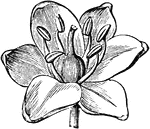
Scilla
Scilla (squill) is a genus of bulb-forming perennial herbs in the Hyacinthaceae. The 90-odd species…
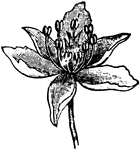
Flowering Rush
The flower of the Flowering Rush (Butomus umbellatus), the sole species in the Butomaceae family.

Common Heath
The flower of the Common Heath (Epacris impressa), a plant in the Ericaceae family of heaths.
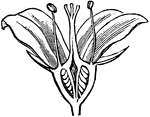
English Dogwood
The English Dogwood (Philadelphus coronarius) is a deciduous shrub, here showing its epigynous stamens…

Winter Aconite
The Winter Aconite (Eranthis hyemalis) is a European plant in the Ranunculaceae family of buttercups.

Bell Heather
The magnified flower of the Bell Heather (Erica cinerea) is a plant in the Ericaceae family of heaths.
Horsetail
An illustration of a fertile branch of horsetail and spore of equisetum with unrolled elaters.
Adderstongue
Lphioglossum (adder's-tongue) is a genus of about 25-30 species of Ophioglossales in the family Ophioglossaceae,…

Flower of a Moss
An illustration of the flower of a moss: ar, archegonium; an, antheridium; p, paraphysis; bl, leaf.

Modern English Flower-Vase
This modern English flower-vase is an oriental style made of blue glazed clay with a black ornament…

Modern Flower-Vase
This modern flower-vase is made out of glazed clay and decorated with different colors.

